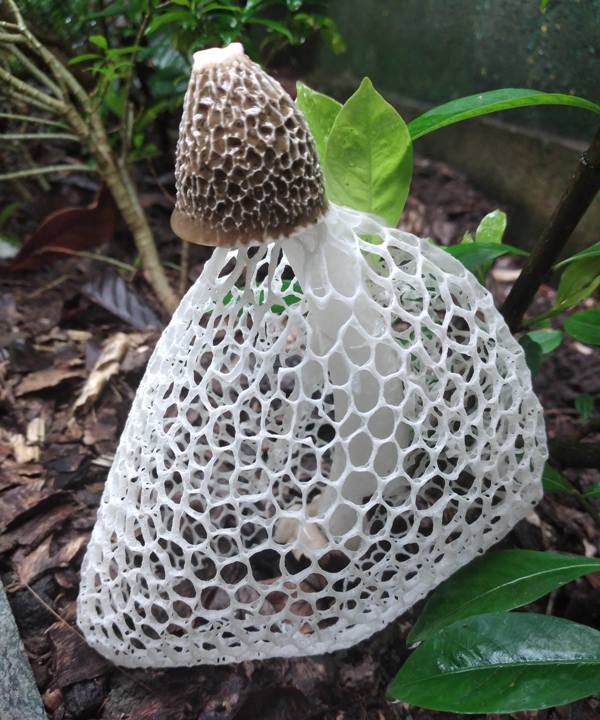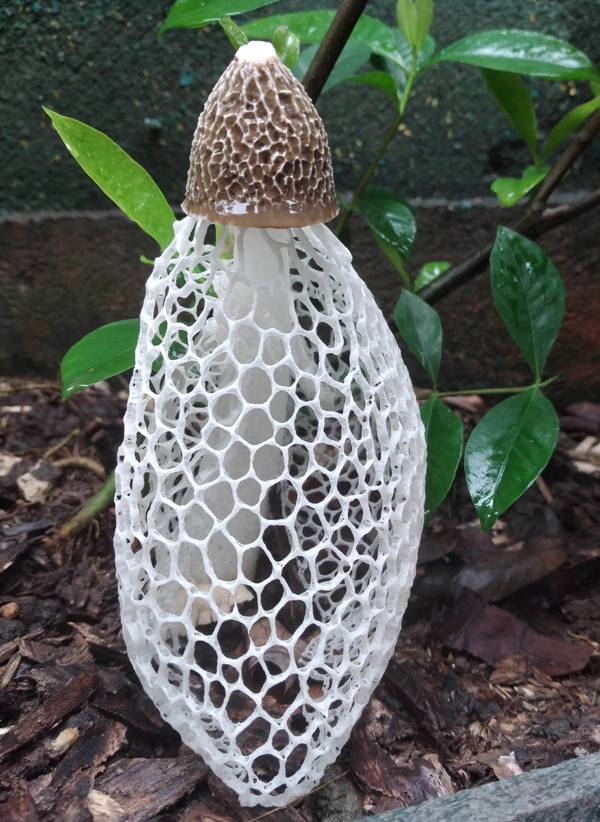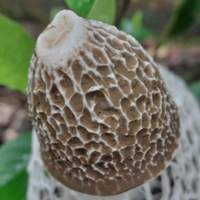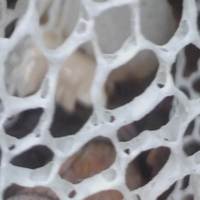Phallus indusiatus Vent. - Bridal Veil Stinkhorn
Phylum: Basidiomycota - Class: Agaricomycetes - Order: Phallales - Family: Phallaceae
Distribution - Taxonomic History - Etymology - Identification - Reference Sources

Phallus indusiatus, the Bridal Veil Stinkhorn, emerges from an underground 'egg'. The cap is initially covered with a smelly olive-green 'gleba' that attracts insects; these insects then distribute spores via their feet.

Distribution
This is a stinkhorn of tropical climes; it is not recorded in Britain and Ireland, although the British Mycological Society has given the common name 'Flasher' to its synonym Phallus duplicatus (see below). The specimens shown here were photographed in Denpasar, Bali, Indonesia.
Taxonomic history
This stinkhorn fungus was first formally described in 1798 by French botanist Étienne Pierre Ventenat (1757 - 1808), who gave it the currently-accepted scientific name Phallus indusiatus (a binomial name that was subsequently sanctioned by Christiaan Hendrik Persoon in his Synopsis Methodica Fungorum of 1801).
Synonyms of Phallus indusiatus include Dictyophora callichroa Möller and Phallus duplicatus Bosc.
Etymology
The genus name Phallus was chosen by Carl Linnaeus, and it is a reference to the phallic appearance of many of the fruitbodies within this fungal group.
The specific epithet indusiatus is Latin and refers to an undergarment or skirt (the lace-like 'indusium'). This species is sometimes referred to as the Crinolene Stinkhorn or Veiled Lady.
Identification guide
 |
DevelopmentFruitbodies of this tropical stinkhorn can be found at any time of year. It is fairly easy to find the 'eggs' of this species, because they are usually only partly buried in woody debris or leaf letter and the whitish skin stands out clearly. Within the egg, the fruitbody develops. Once the peridium of the egg ruptures to form a volva, the 'horn' emerges in a matter of a few minutes, and then gradually the lacy white veil descends almost to the ground. (The bottom of the veil turns yellowish as it begins to decay.) Fruitbody is typically 15 to 25cm tall; stipe diameter 1.5 to 2.5cm; cap 1.5 to 4cm across. |
 |
CapThe stipe (stem) is topped by a flat-topped conico-convex cap, broader than the stem, covered in olive-brown spore-bearing gleba. The raised honeycomb texture of the cap is visible beneath the gleba. As soon as the cap emerges from the egg, insects attack it and eat the gleba. Some of the sticky gleba adheres to the legs of the insects; that is how the spores get carried from one location to another. |
 |
StemThe white stipe has the texture and appearance of expanded polystyrene; it persists for just a day or two after the gleba has been consumed by insects. Veil or IndusiumFrom the stem apex, a lace-like skirt or indusium billows out and descends often to substrate level. Like the rest of the fruitbody, the lace is short lived. |
SporesEllipsoidal to cylindrical, smooth, 2.5-3.5 x 1-1.5µm. Spore colourThe slimy gleba, which is dark olive, contains yellowish spores. Their suspension in gleba makes it impossible to produce a conventional spore print. |
|
Odour/taste |
A strong, sickly-sweet odour; no distinctive taste. |
Habitat |
Phallus indusiatus is found in tropical forests as well as in mulched gardens and other humous-rich disturbed ground. |
Season |
Throughout the year. |
Similar species |
Phallus multicolor has a yellow skirt. Phallus hadriani, the Dune Stinkhorn, which occurs in Britain and Ireland, has no skirt and a violet-coloured volva; it is found almost always in sand dunes. Mutinus caninus, the Dog Stinkhorn, is much smaller and has a weaker odour; its honeycombed cap is the same diameter as the stipe, and its cap surface is orange rather than white beneath the gleba. |
Acknowledgements
This page includes pictures kindly contriuted by John Tatnell.
Reference Sources
Dictionary of the Fungi; Paul M. Kirk, Paul F. Cannon, David W. Minter and J. A. Stalpers; CABI, 2008
Taxonomic history and synonym information on these pages is drawn from many sources but in particular from the British Mycological Society's GB Checklist of Fungi.
Fascinated by Fungi. Back by popular demand, Pat O'Reilly's best-selling 450-page hardback book is available now. The latest second edition was republished with a sparkling new cover design in September 2022 by Coch-y-Bonddu Books. Full details and copies are available from the publisher's online bookshop...

